与中国科学院、清华大学等建立了紧密的技术合作关系,
与中国航天科技集团、中国电子科技集团建立了全方面的战略合作关系
Impedance and phase of automotive LISNs according to CISPR16-1-2
The 5μH+1Ω LISN
CISPR16-1-2:2014 section 4.5 defines the impedance of the LISN according to figure 1. Because of the high DC resistance, it cannot be put in series with the load, as the resulting voltage drop would be unac-ceptable. Therefore, it is required to modify the circuit to approximate the given imped-ance without putting a DC resistance in series with the equipment under test. CISPR16-1-2/Fig. 5 shows a possible solution. It is shown in simplified form in figure 2. The resistive part of the low-frequency impedance is connected in parallel with the power supply (via a decoupling capac-itor) assuming that the power supply im-pedance will always be greater than 1 Ω. Even when the power supply impedance is low there is nearly no impact on the magnitude of the LISN impedance. This does not hold true for the phase (see. figure 3).
Phase difference with AE shorted
Shorting the AE port of the LISN shorts the 1 Ω-resistor. The LISN has become a 5 μH || 50 Ω LISN. This results in a theo-retical phase error of 11.88° in case of a perfect short and exceeds the error budg-et of 11.5°. Because of losses in the in-ductor and associated components the quality factor of the inductor is reduced, reducing the phase error in the process. This makes the practical LISN barely pass the tests. Solving this issue would require an extra filter choke at the input, which – while possible – would increase the complexity and is not described in CISPR16-1-2. This choke would need to be of larger value – as in the 50 μH mains LISN – causing additional cost, size and heat issues. It would also require a different LISN (with-out filter choke) for ISO7637-2. CISPR16-1-2 accounts for this by requir-ing very low decoupling at low frequen-cies. Unfortunately, this has not been applied to phase limits.
Possible solutions
It is up to the CISPR comittee to resolve the normative issue. But it is still possible to use the LISN, even when the phase response is out of the CISPR16-1-2 limits: In most cases the relevant standard is CISPR25. CISPR25 has different limits, so a calibration according to CISPR16-1-2 is not valid for CISPR25. Because CISPR25 does not include phase limits, a calibration according to this standard is easily passed. If compliance to CISPR16-1-2 is really required and the suitability of the LISN cannot be confirmed with the appropriate certainty CISPR16-1-2 section 4.2 allows to increase the phase margin by including the increased phase margin into the un-certainty budget. This way the missing approx. 2° phase can be accounted by additional tenths of dB uncertainty.




